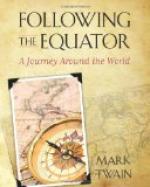Two millions of natives arrive at this fair every year. How many start, and die on the road, from age and fatigue and disease and scanty nourishment, and how many die on the return, from the same causes, no one knows; but the tale is great, one may say enormous. Every twelfth year is held to be a year of peculiar grace; a greatly augmented volume of pilgrims results then. The twelfth year has held this distinction since the remotest times, it is said. It is said also that there is to be but one more twelfth year—for the Ganges. After that, that holiest of all sacred rivers will cease to be holy, and will be abandoned by the pilgrim for many centuries; how many, the wise men have not stated. At the end of that interval it will become holy again. Meantime, the data will be arranged by those people who have charge of all such matters, the great chief Brahmins. It will be like shutting down a mint. At a first glance it looks most unbrahminically uncommercial, but I am not disturbed, being soothed and tranquilized by their reputation. “Brer fox he lay low,” as Uncle Remus says; and at the judicious time he will spring something on the Indian public which will show that he was not financially asleep when he took the Ganges out of the market.
Great numbers of the natives along the roads were bringing away holy water from the rivers. They would carry it far and wide in India and sell it. Tavernier, the French traveler (17th century), notes that Ganges water is often given at weddings, “each guest receiving a cup or two, according to the liberality of the host; sometimes 2,000 or 3,000 rupees’ worth of it is consumed at a wedding.”
The Fort is a huge old structure, and has had a large experience in religions. In its great court stands a monolith which was placed there more than 2,000 years ago to preach (Budhism) by its pious inscription; the Fort was built three centuries ago by a Mohammedan Emperor—a resanctification of the place in the interest of that religion. There is a Hindoo temple, too, with subterranean ramifications stocked with shrines and idols; and now the Fort belongs to the English, it contains a Christian Church. Insured in all the companies.
From the lofty ramparts one has a fine view of the sacred rivers. They join at that point—the pale blue Jumna, apparently clean and clear, and the muddy Ganges, dull yellow and not clean. On a long curved spit between the rivers, towns of tents were visible, with a multitude of fluttering pennons, and a mighty swarm of pilgrims. It was a troublesome place to get down to, and not a quiet place when you arrived; but it was interesting. There was a world of activity and turmoil and noise, partly religious, partly commercial; for the Mohammedans were there to curse and sell, and the Hindoos to buy and pray. It is a fair as well as a religious festival. Crowds were bathing, praying, and drinking the purifying waters, and many sick pilgrims had come long journeys




